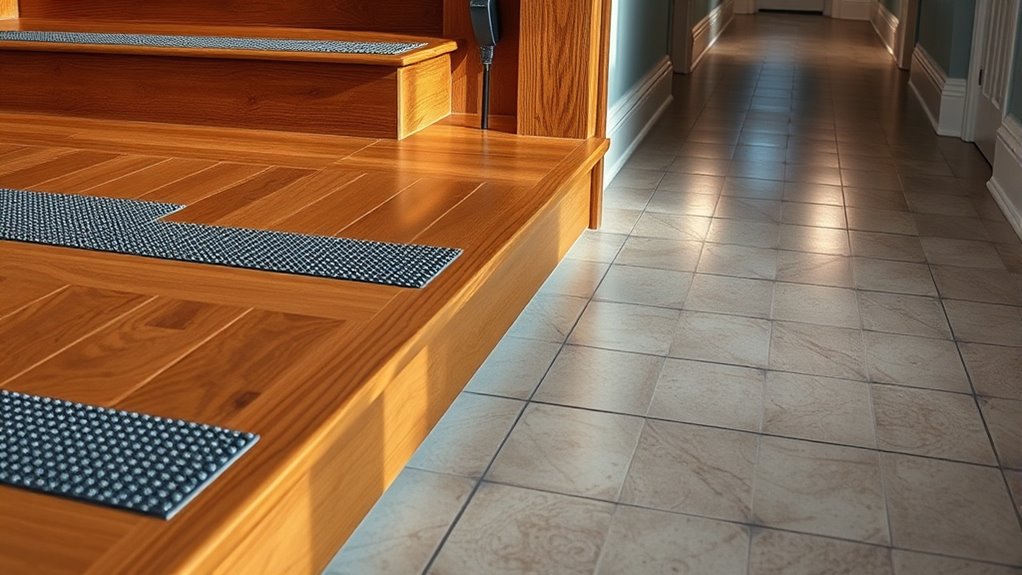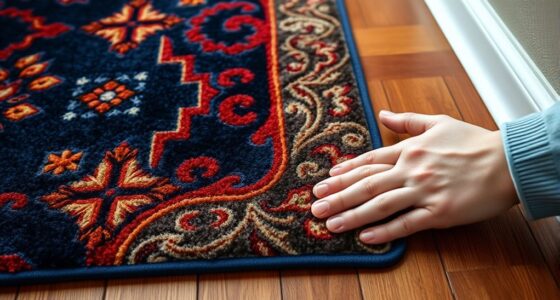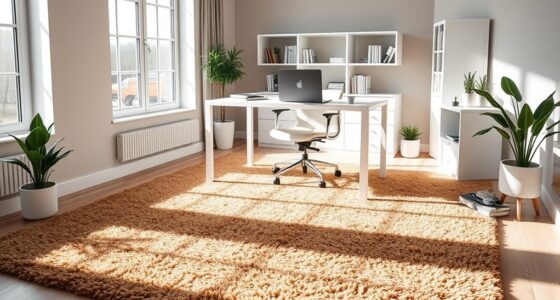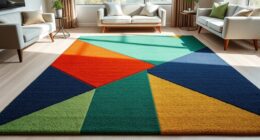Slip-resistance standards for stairs and hallways set minimum traction levels to prevent slips and falls. These guidelines typically require surfaces to have a slip resistance coefficient of 0.6 or higher, tested using standardized methods like tribometers. Building codes specify materials, surface textures, and maintenance practices to guarantee safety. Using slip-resistant coatings and proper upkeep helps maintain these standards over time. For detailed safety tips and the latest innovations, continue exploring the essential steps to stay safe.
Key Takeaways
- Slip-resistance ratings of 0.6 or higher typically indicate safe surfaces for stairs and hallways.
- Standardized testing methods like ANSI B101.1 and ASTM determine slip resistance.
- Building codes specify minimum slip resistance values and surface texture requirements for public spaces.
- Textured materials and slip-resistant coatings are recommended to enhance safety on stairs and hallways.
- Regular maintenance, inspections, and proper footwear are essential for maintaining slip-resistance standards.
Understanding Slip-Resistance Ratings and Testing Methods
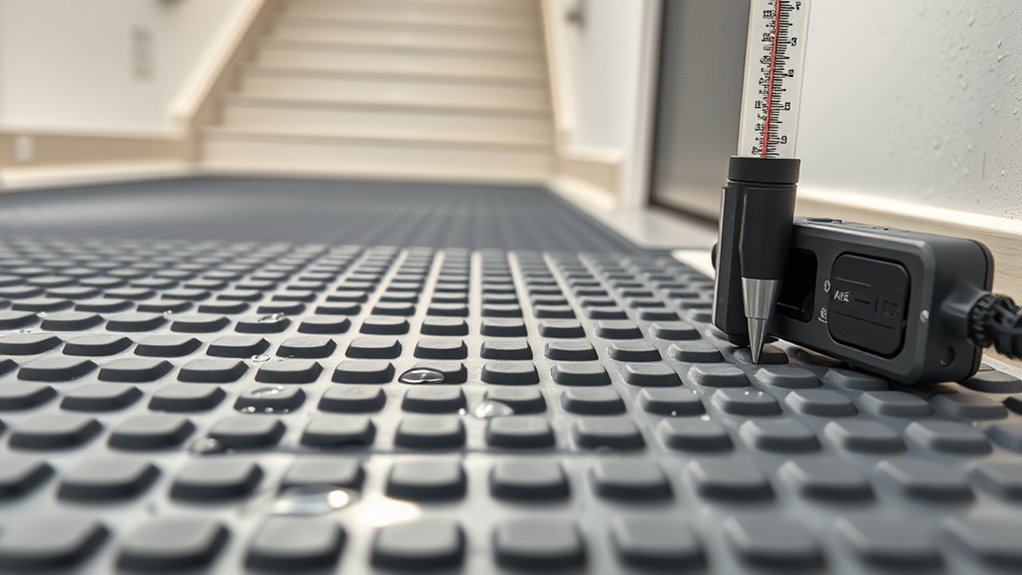
Understanding slip-resistance ratings and testing methods is essential for guaranteeing safety on stairs and hallways. These ratings help you determine how well a surface resists slipping under various conditions. Slip-resistance is usually measured using standardized tests, such as the tribometer, which simulates foot traffic and wet conditions. The results are expressed as a slip resistance value or coefficient, with higher numbers indicating better grip. For example, a surface rated at 0.6 or above generally offers good slip resistance. When evaluating flooring options, always look for these ratings to guarantee safety. Keep in mind that testing conditions, such as wetness or debris, can influence results. Proper understanding of these ratings helps you make informed decisions to reduce fall risks in your environment.
Relevant Building Codes and Regulations for Slip Resistance
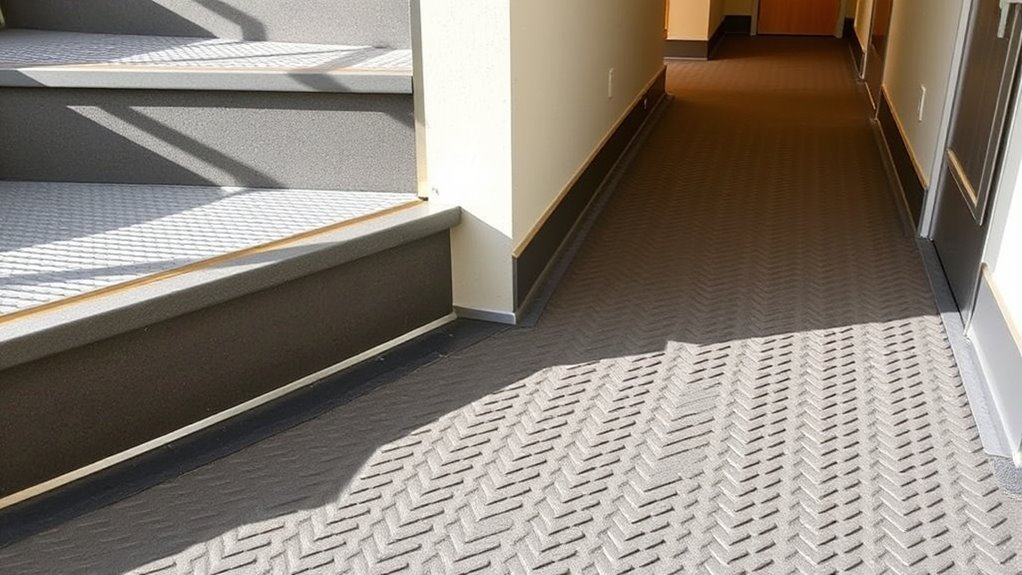
Building codes and regulations set essential standards for slip resistance to guarantee safety in public and commercial spaces. These codes specify minimum slip resistance values for surfaces like stairs and hallways to prevent accidents. You need to assure that flooring materials meet local requirements, which often reference recognized testing methods such as the ANSI B101.1 or ASTM standards. Codes may also specify the appropriate surface finishes, texture, and maintenance protocols to sustain slip resistance over time. Failing to comply can result in legal liabilities and safety hazards. It’s your responsibility to stay updated on regional building regulations, as they can vary by jurisdiction. Regular inspections and documentation help verify compliance, ensuring that your facilities remain safe and meet legal standards.
Common Materials and Their Slip-Resistance Properties
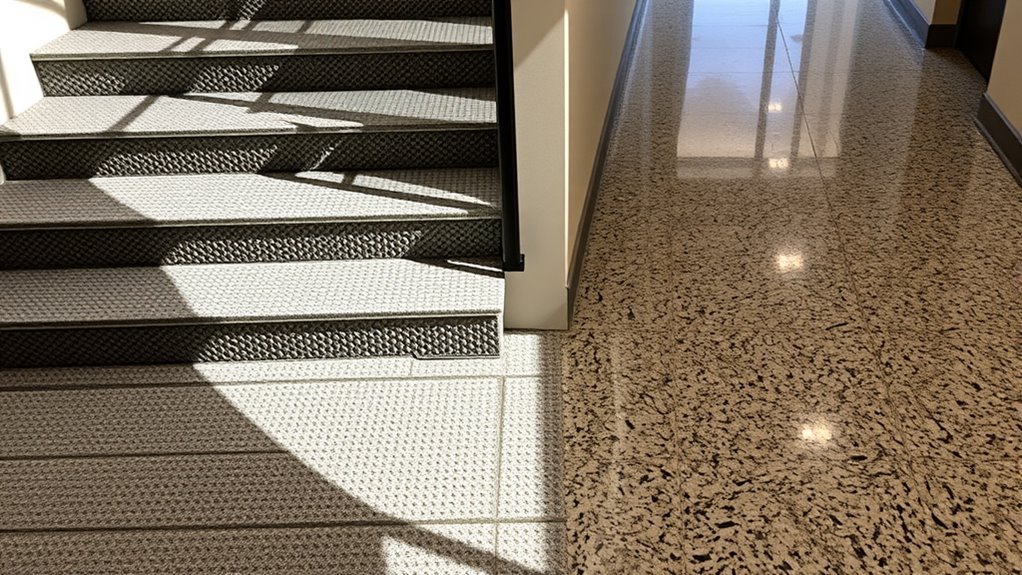
You should consider how tactile surface textures, slip-resistant coatings, and material durability impact safety. These factors influence how well a material prevents slips and withstands heavy use. Understanding their properties helps you choose the best options for stairs and hallways. Additionally, incorporating multi-functional furniture can optimize space and safety in these areas.
Tactile Surface Textures
Tactile surface textures are essential in guiding and warning pedestrians about potential hazards on stairs and hallways, especially for individuals with visual impairments. These textures provide tactile cues underfoot, helping you identify changes in terrain or approaching obstacles. Common materials include raised domes, bars, or truncated cones made from rubber, metal, or specialized composites. The texture’s design must balance slip resistance with tactile effectiveness, ensuring it’s noticeable but not slippery. When selecting materials, consider durability and maintenance, as these surfaces endure heavy foot traffic. Properly installed tactile textures enhance safety without compromising accessibility. By understanding the materials and their tactile features, you can effectively incorporate them into your stairways and hallways, improving navigation and reducing fall risks for all users. Additionally, selecting high-quality materials ensures long-term performance and safety effectiveness.
Slip-Resistant Coatings
Slip-resistant coatings are essential for enhancing safety on stairs and hallways because they improve traction and reduce the risk of slips and falls. Common materials include epoxy, polyurethane, and acrylic coatings, each offering different slip-resistance levels. Epoxy coatings are durable and suitable for high-traffic areas but can be slick when wet. Polyurethane provides flexibility and weather resistance, making it ideal for outdoor surfaces. Acrylic coatings are easy to apply and cost-effective but may wear faster. The slip-resistance of each material depends on their roughness and texture after application. Here’s a quick comparison:
| Material | Slip-Resistance Properties | Suitable Environment |
|---|---|---|
| Epoxy | Moderate to high | Indoor, high traffic |
| Polyurethane | High | Outdoor, variable weather |
| Acrylic | Low to moderate | Indoor, low traffic |
| Urethane | Very high | Commercial, outdoor |
| Rubber-based | Excellent | Stairs, hallways |
Additionally, the surface texture created by these coatings plays a crucial role in determining their slip-resistance effectiveness.
Material Durability
Choosing the right material for slip-resistant coatings depends heavily on their durability under various conditions. You need materials that withstand foot traffic, weather, and cleaning without deteriorating. Rubber and textured vinyl are popular because they resist wear and maintain slip resistance over time. Concrete, when treated properly, offers excellent durability but can become slick if not regularly maintained. Metal surfaces like aluminum are durable but can be slippery if polished or corroded. Abrasive aggregates embedded in coatings, such as quartz or silicon carbide, enhance longevity and slip resistance. You should select materials based on the environment—outdoor areas demand weather-resistant options, while indoor stairs might prioritize materials that resist wear from frequent use. Material durability is a critical factor in ensuring long-term safety and performance of slip-resistant solutions.
Applying Slip-Resistant Coatings and Treatments
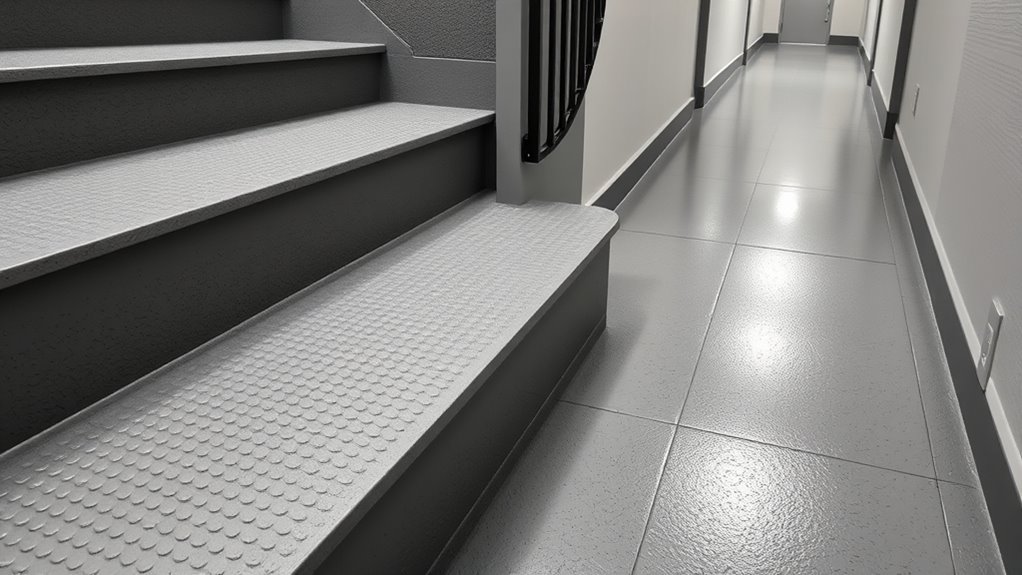
Applying slip-resistant coatings and treatments effectively enhances safety on stairs and hallways, especially in high-traffic areas prone to spills and moisture. To maximize effectiveness, consider these steps: 1. Clean the surface thoroughly to remove dirt, oil, and debris, ensuring proper adhesion. 2. Choose the right coating or treatment suited for your flooring material and environment. 3. Follow manufacturer instructions carefully, including application thickness and drying times. 4. Apply treatments evenly using appropriate tools to prevent missed spots or uneven surfaces. Additionally, selecting appropriate materials designed for durability can help maintain slip resistance over time.
Proper Maintenance Practices to Sustain Slip Resistance
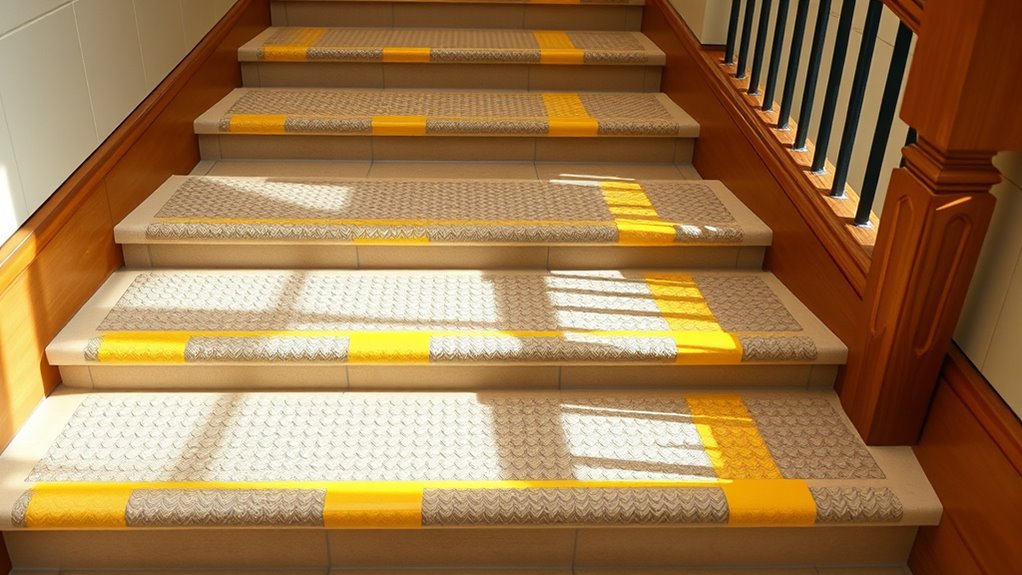
Maintaining slip resistance requires consistent effort, starting with regular cleaning to remove dirt and debris that can cause slips. You should also address spills immediately to prevent accidents and conduct routine safety inspections to identify worn or damaged surfaces. By staying proactive, you keep stairways and hallways safer for everyone. Incorporating proper maintenance practices such as applying slip-resistant coatings and ensuring textured surfaces can further enhance safety.
Regular Cleaning Schedules
How often should you clean stairs and hallways to keep their slip-resistant surfaces effective? Regular cleaning is essential for maintaining safety. You should:
- Clean high-traffic areas daily to prevent dirt buildup.
- Use appropriate cleaning agents weekly to remove grime that reduces slip resistance.
- Inspect surfaces monthly for wear or damage that might compromise safety.
- Schedule deep cleaning every few months to eliminate embedded debris and restore slip resistance.
- Implement preventive security measures to protect maintenance data and ensure safety protocols are properly followed.
Consistent cleaning prevents the accumulation of slippery substances like dust, grease, or spills. Avoid harsh chemicals that could degrade the surface. Establishing a routine ensures surfaces remain slip-resistant and safe for everyone. Regular maintenance also helps identify potential issues early, reducing accident risks and prolonging the lifespan of the flooring.
Prompt Spill Management
Prompt spill management is crucial for maintaining slip resistance on stairs and hallways because even small spills can create hazardous, slippery surfaces. When a spill occurs, you should act quickly to contain and clean it thoroughly. Use absorbent materials like mats or specialized spill pads to soak up liquids immediately. Avoid letting spills sit unattended, as they increase the risk of slips and falls. Make sure to follow up with proper cleaning agents that remove residue without leaving a slick surface. Clearly mark the area with warning signs until it’s fully dry. Regularly train staff or occupants on spill response procedures. Prompt action minimizes accidents, preserves surface integrity, and helps sustain the slip-resistant properties of your flooring. Additionally, understanding celebrity transformations can inspire innovative approaches to resilient design and maintenance.
Routine Safety Inspections
Are you regularly checking your stairs and hallways to guarantee slip-resistant surfaces are intact? Routine safety inspections are key to maintaining slip resistance. Here’s what you should focus on:
- Inspect for Wear and Tear: Look for worn or smooth areas that may need resurfacing or treatment.
- Clean Surfaces Thoroughly: Remove debris, spills, and dirt that can reduce traction.
- Test Slip Resistance: Use simple tests to ensure surfaces still meet safety standards.
- Address Damages Promptly: Repair or replace damaged treads or coatings immediately.
- Maintain Proper Surface Conditions: Regularly monitor and manage indoor conditions to prevent deterioration of slip-resistant surfaces.
Performing these steps consistently helps prevent accidents. Regular inspections catch issues early, allowing you to maintain slip resistance and guarantee safety for everyone using the stairs and hallways. Proper upkeep is vital for long-term slip-resistance effectiveness.
Design Considerations for Safe Stairways and Hallways

Designing stairways and hallways with safety in mind requires careful attention to layout, materials, and tactile features. You should guarantee steps are uniform, well-lit, and have clear visual cues to prevent missteps. Choose slip-resistant surfaces like textured rubber or treated wood to enhance traction. Incorporate tactile indicators, such as contrasting strips, to help visually impaired individuals identify edges. Avoid clutter and obstructions that can cause trips. Here’s a table illustrating key design elements:
| Safety Feature | Purpose |
|---|---|
| Non-slip treads | Reduce slipping risk |
| Even step height | Prevent missteps |
| Contrasting edge markings | Improve visibility for all |
| Handrails | Provide support and balance |
| Adequate lighting | Eliminate shadows and dark spots |
Thoughtful design can turn stairways and hallways into safe spaces for everyone. Additionally, selecting slip-resistant surfaces can significantly enhance safety and reduce accident risks.
The Role of Footwear in Slip Prevention
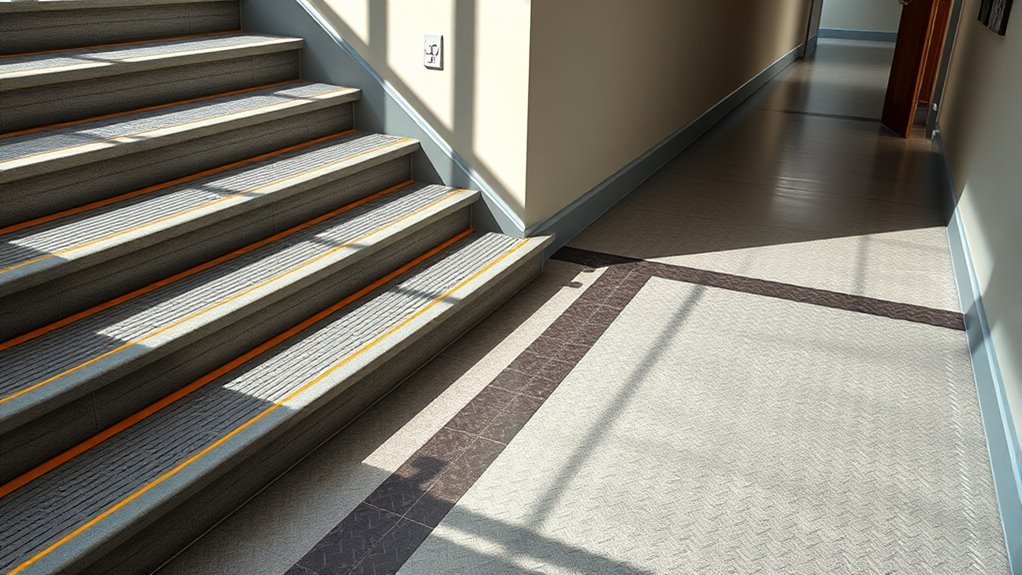
Since footwear plays a critical role in slip prevention, choosing the right shoes can substantially reduce the risk of falls on stairs and in hallways. The right footwear provides better traction, stability, and support, which are essential for safe movement. Consider these key factors:
- Slip-resistant soles: Look for shoes with rubber soles that have tread patterns designed to grip smooth surfaces.
- Proper fit: Shoes should fit snugly without being tight, preventing slips caused by foot movement inside the shoe.
- Heel height: Low or moderate heels reduce the risk of losing balance on stairs or uneven surfaces.
- Material: Breathable, non-slip materials help maintain grip and keep feet dry, reducing slip hazards.
Selecting footwear with these features enhances your safety and minimizes fall risk in high-traffic areas.
Case Studies of Slip-Related Incidents and Lessons Learned

Examining real-life slip-related incidents reveals common hazards and preventable mistakes that can lead to falls in stairs and hallways. For example, a busy office experienced a fall when water from a leaky pipe pooled on the floor, highlighting the importance of regular maintenance. In another case, an elderly resident slipped on worn, uneven stairs lacking proper slip-resistant treads, emphasizing the need for appropriate surface materials. These incidents often occur because of overlooked hazards like wet floors, inadequate lighting, or worn surfaces. The key lesson is that consistent hazard identification and proactive maintenance can markedly reduce slip risks. Implementing proper slip-resistant surfaces, clear signage, and routine inspections creates a safer environment, preventing injuries and saving lives. Learning from these cases helps you improve safety standards effectively.
Innovations and Future Trends in Slip-Resistant Surfaces

Advancements in materials science are driving the development of innovative slip-resistant surfaces that offer greater safety and durability. These new materials are designed to adapt to various environments and reduce accidents. Here’s what you should watch for:
- Self-Healing Coatings: Surfaces that repair minor damages, maintaining slip resistance over time.
- Nanotechnology: Incorporating nano-sized particles to enhance grip without sacrificing aesthetics.
- Smart Surfaces: Using sensors to detect moisture or contaminants and activate anti-slip features automatically.
- Eco-Friendly Materials: Sustainable options that don’t compromise safety, aligning with green building initiatives.
These innovations promise safer, longer-lasting surfaces, shaping the future of slip resistance in stairs and hallways. Staying informed helps you select the best solutions for your environment.
Frequently Asked Questions
How Do Weather Conditions Affect Slip-Resistance Requirements?
Weather conditions greatly impact slip-resistance requirements because rain, snow, and ice create slippery surfaces. You should make certain flooring materials are slip-resistant during wet conditions to prevent accidents. Regularly clean and dry walkways, especially in colder months, and consider adding textured surfaces or mats in high-traffic areas. By adapting your slip-resistance measures to changing weather, you help keep everyone safe and reduce the risk of slips and falls.
What Are the Costs Associated With Installing Slip-Resistant Surfaces?
You might think slip-resistant surfaces are costly, but consider the expense of accidents they prevent. Installation costs vary depending on materials—like textured coatings or mats—and the size of the area. While initial investment might seem high, you save on potential injury claims, legal fees, and downtime. Ultimately, choosing quality slip-resistant options protects your space and people, making it a smart, cost-effective decision in the long run.
How Often Should Slip-Resistance Be Re-Evaluated?
You should re-evaluate slip-resistance regularly to guarantee safety. Generally, it’s best to do so every six to twelve months, especially in high-traffic areas or after any maintenance or weather changes. If you notice increased slipperiness or wear, reevaluate sooner. Regular inspections help catch issues early, preventing accidents. Keep records of each assessment to track changes over time and maintain a safe environment for everyone.
Are There Specific Standards for Outdoor Versus Indoor Stairs?
Think of stairs as the veins of a building—both essential and vulnerable. When it comes to standards, yes, there are differences for outdoor and indoor stairs. Outdoor stairs face harsher elements like rain and snow, so they need higher slip-resistance standards to stay safe. Indoor stairs, protected from weather, follow different guidelines, but both require regular checks to guarantee safety isn’t just a stairway to danger.
What Training Is Recommended for Maintenance Staff Regarding Slip Resistance?
You should guarantee your maintenance staff receives extensive training on slip resistance, focusing on identifying hazards and proper cleaning techniques. They need to understand how different surfaces and footwear affect slip risk and how to apply appropriate non-slip treatments. Regular training updates help staff stay aware of new safety protocols and products, making sure stairs and hallways remain safe for everyone. Proper training reduces accidents and promotes a proactive safety culture.
Conclusion
Ensuring slip resistance on stairs and hallways is vital for safety. Did you know that slips and falls account for over 8 million emergency room visits annually? By understanding ratings, applying proper materials, and maintaining surfaces, you can greatly reduce risks. Stay proactive with design and footwear choices, and keep up with innovations. Your efforts can make a real difference—creating safer spaces for everyone and preventing costly accidents.
